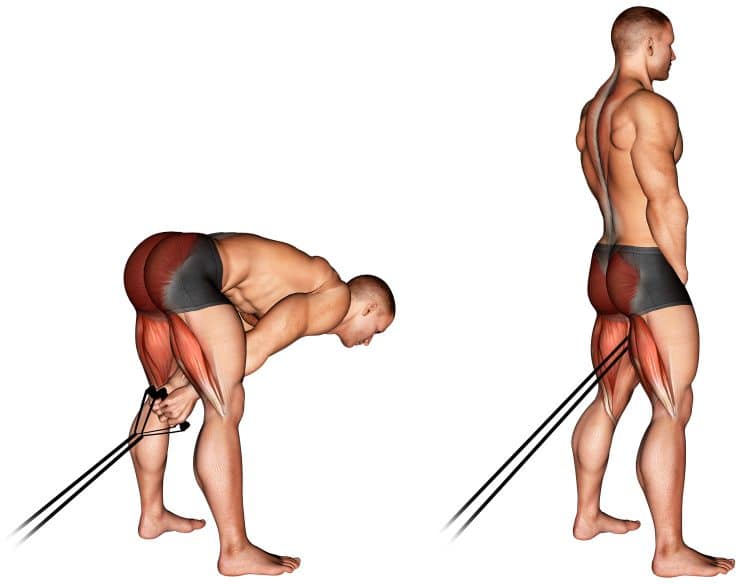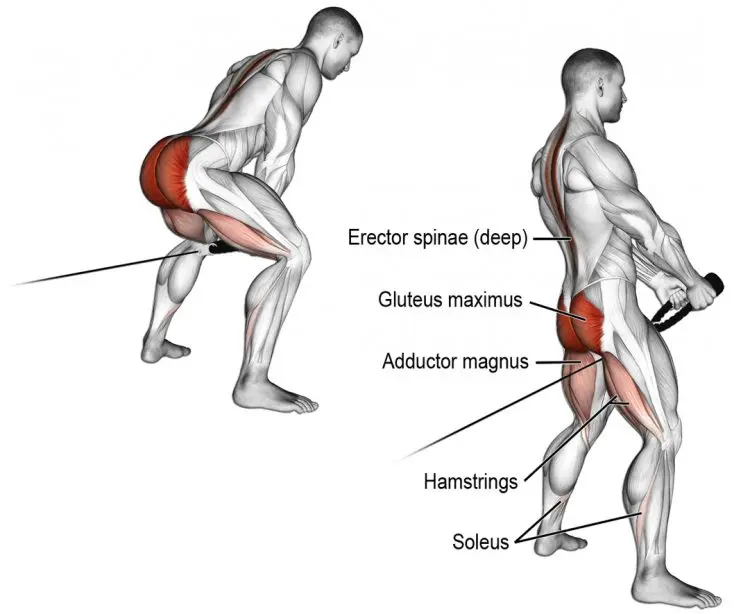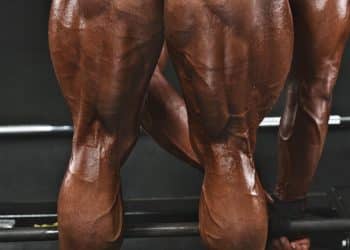The band pull through is probably one of those exercises that you never gave much thought to. Either because it didn’t appeal to your training style, or you didn’t imagine significant benefits from doing it. However, if you train at home, it offers a unique advantage for the muscles on your backside like the glutes, hamstrings, and lower back. That is being able to somewhat replicate the design of a cable machine, where you can draw power from your legs and core, and drive the hips forward like in a deadlift variation.
These are essential movement patterns, not just for the athlete, or hardcore lifter, but also for those with physically demanding occupations, or even the elderly who desire longevity, which relies heavily on hip strength, health, and function.
Learn about more benefits, common mistakes, variations, and alternatives in this complete band pull through training guide.
How To Do The Band Pull Through
When it comes to band training, you need a setup equally as good as the technique due to the nature of elastic bands. This way you can effectively challenge yourself session after session, especially if bands are one of your primary methods of the pull through technique.
Below are written step by step instructions, and a easy to follow video demonstration with key form tips.
Steps
- Anchor your band as low as it can go to a sturdy object.
- Face away from the anchor point (Rack, door, etc) then grab the band/handles in both hands between your legs with a neutral grip.
- Stand up and walk slightly forward until there’s tension in the band/s.
- Start from a standing position, with your feet roughly hip width apart, shoulder pinned back, and core strongly engaged.
- Now send your hips back, and lean forward as much as you can but while keeping a straight back. You should feel a deep stretch in the hamstring muscles.
- Finally, squeeze your glutes and push the hips forward into a standing position.
Watch a detailed, mini tutorial video lesson on the band pull through via the following YouTube clip.
Level Up Your Fitness: Join our 💪 strong community in Fitness Volt Newsletter. Get daily inspiration, expert-backed workouts, nutrition tips, the latest in strength sports, and the support you need to reach your goals. Subscribe for free!
Tips
- Step farther away from the anchor point for more resistance.
- Use any band, just make sure it’s challenging enough without offering too much resistance causing you to strain and train the muscles unevenly with decreased focus and muscle activation. Typically, a thicker, and hence heavier band is optimal for band pull throughs.
- You can use a stance that feels optimal for you. For example, some people like to use a conventional deadlift stance with the feet hip width, and others prefer a wider stance with the toes pointed slightly out.
This Exercise:
- Target muscle group: Gluteus maximus, hamstrings, and erector spinae
- Type: Hypertrophy, muscle and joint health
- Mechanics: Isolation
- Equipment: Band and anchor point
- Difficulty: Intermediate
Muscles Worked During The Band Pull Through
If you’ve got a band and some place to anchor it, like a door attachment, you can have access to a powerful hip-based movement that challenges all the muscles on the backside of your body.

- Gluteus maximus – The powerhouse of butt muscles, gluteus maximus (GM) comprises the meatiest and strongest of three gluteal heads in your backside that straightens your body at the hips like in the finishing position of a band pull through.
- Hamstrings – Supported by three muscles that cross the hips and knee on your backside, hamstrings straighten your hips and bend your knee.
- Erector spinae – A family of muscle fibers residing on both sides of the spine from the hips to the base of the skull. When erector spinae contracts, we can stand up straight, laterally bend, and rotate the upper body.
- Adductor magnus – The king of adductors both by size and might, adductor magnus fibers forcefully adduct the thigh, while flexing and extending it too.
- Calves – Go below the knee and you’ll find the two primary calves muscles; gastrocnemius and soleus. The former is the bigger, more evident muscle while soleus lies underneath. Athletic muscles by design, the calves help us run and jump with fast plantarflexion (Pressing the toes down and lifting the heel up).
Benefits of The Band Pull Through
The benefits of band pull throughs are more than worth the efforts of this simple yet effective home friendly posterior exercise.
Draw more eyes to your backside
We oftentimes don’t realize how much better our posterior muscles should be, as we don’t usually get to stare at the back, glutes, hamstrings, and calves together in one view like we do the chest, abs, quads, etc. And the honest truth is that unless you have a dedicated training routine, you could probably use much more posterior work, otherwise succumb to what appears like a flat backside.
Build a better butt: Three glute workouts for women
Teach your glutes to drive
The great thing about bands and cables is the direction of the resistance. Because the band is pulling you back toward the anchor point, driving the hips forward and squeezing the glutes in the opposite direction may feel more natural or ergonomic than using a barbell, for example. Therefore, sometimes we need these types of variations to reinforce optimal muscle movement.
Speaking of glutes, let’s talk about the athletic benefits.
Less lower back, more glutes and hammies…
Similar movements holding a loaded bar or dumbbells force heavy core engagement to protect the spine and get the lift! Band pull throughs and pull throughs, in general, create less load on the lower back, and tend to focus more stimulation toward the glutes and hips with less range of movement.
But on the flipside of the coin, band pull throughs could help you to build a stronger lower back and core too.
Improve athletic prowess
Like the kettlebell swing, band pull throughs involve full hip and knee extension which are key elements of athletic performance that rapidly activate the powerful behind muscles like butt, hamstrings, and calves. You can enhance explosive power and a combination of muscle and joint quickness by performing reps at faster speeds like the following video example.
Walk like a king!
As much as we’re forced into bad postural habits these days due to our device obsessions, we owe it to ourselves to take posterior training seriously. Not just because hunching over is ugly, but too much of that and it can wreak havoc on our necks, shoulders, head, back, and even the nerves and vessels in our anterior torso, also known as thoracic outlet syndrome. Training the hamstrings, glutes, and spinal muscles will help maintain good posture so we can strut our stuff!
Common Mistakes During The Band Pull Through
Before you perform the first rep, make sure that you’ve gone through the step by step checklist under the “how to do band pull throughs” section that’s also accompanied by a brief video example. These common mistakes are just a few pointers to help you tighten up, and ensure the best movement mechanics and gains.
Not pre stretching the band
While it’s not doomsday if you make this mistake, you’ll disengage the target muscles which will affect the beneficial aspect of training a muscle through its full range of motion. That includes strengthening the fibers both during the concentric and eccentric portions of the repetitions, fortifying the joints in the process.
Level Up Your Fitness: Join our 💪 strong community in Fitness Volt Newsletter. Get daily inspiration, expert-backed workouts, nutrition tips, the latest in strength sports, and the support you need to reach your goals. Subscribe for free!
Before you start your pull throughs, walk forward until the band is stretched, even if just slightly and as your strength abilities will allow. Then begin your set.
Bridging the back
As the name implies, your back shouldn’t resemble a bridge or hump. Instead, keep a flat torso to protect your back and prevent excessive loading with the spine and surrounding muscles in a vulnerable position.
We realize body proportions and limb length affect how deep you can lean forward but don’t sweat it. Practice with a light band, and film your form to ensure your back is straight. Feeling a nice stretch in the hamstrings, and getting decent hip thrust with strong glutes is the goal here.
Hyperextending your lower back
Referring to the phase of a band pull through where you stand up straight. Yes, there’s a slight exaggeration of standing upright because we’re supposed to squeeze the glutes. But don’t push your hips so far forward or lean back into the exercise. The body should never go beyond neutral during the positive portion of your rep.
Making it too easy or difficult
Don’t be afraid to use some real resistance in a 8-12 rep range that really makes you work for those last few reps. But only if you can do it with proper form. Your posterior muscles are a strong group of muscles that need heavy resistance to get stronger, and show more physical development.
There is a time and place for lighter resistance, higher rep sessions, or you can combine high and low intensity sets in a training session. But once you can perform more than 30 reps in a set, approaching muscular failure, then you need to up the dose (Training load).
Variations and Alternatives of The Band Pull Through
The following exercises share similarities and differences to the band pull through, and you can use them as an alternative or compliment.
Cable pull through

If you prefer a more consistent loading pattern, we recommend cable pull throughs. You’ll feel the same amount of resistance from start to finish of each rep, can easier track your gains with the numbered weight stack, and you don’t need as much setup time. Seeing as you have to stand a certain distance from your anchor point with bands to create resistance, whereas cables are much simpler.
Kettlebell swing
The band pull through is essentially a kettlebell swing without a kettlebell. There are some significant differences though. Kettlebells are usually made from cast iron or steel while bands are latex or rubber. Therefore, the heavier the kettlebell, the larger its size, whereas bands are contained in their tubed or rubberband-like shape and take up less space.
The other big difference between the two is the momentum required for a kettlebell swing, and the ability to have better control during the banded version. Then, finally, the hip swing should swing the arms up to roughly chest height while your arms stay down near the hips during band pull throughs.
Band Romanian deadlift
An alternative option and certainly a fan favorite, there’s no reason you shouldn’t take advantage of band Romanian deadlifts if you workout at home.
Steps
- Grab your bands in both hands then anchor them down with your feet.
- Stand straight up in the starting position.
- Pinch your shoulder blades back and tense your core muscles to prepare for the hip hinge.
- Now, lean forward at the waist as far as you can comfortably bend without rounding your back and bend your knees slightly. You should feel your hamstrings stretching.
- Stand straight up, then repeat steps 4 and 5 until you think you’ve hit the optimal number of repetitions.
Hip thrust
Whether it’s done with bands or a barbell, hip thrusts are a savage glute and hamstring exercise. Having the load on the hips and not the entire says everything about the unique nature of this movement. Although you still need a strong back, but the glutes and hips really do the pushing here.
Find every type of hip thrust variation here.
Band stiff legged deadlift
You don’t need anything to anchor your band for this exercise, just your own two feet! Hence band stiff legged deadlifts (BSLD) are closer to an actual deadlift due to the direction of your pull. You’ll probably feel the need to engage your core more in a BSLD too. So utilize both for the benefits that they offer.
FAQ’s
What are the best sets and reps for band pull throughs?
Keep things in a moderate 2-3 sets of 8-12 reps range to build strength, muscle mass, and optimal hip hinge technique.
What's the best type of resistance band for pull throughs?
Any standard length resistance will be adequate for band pull throughs as long as you can properly anchor it at the appropriate height.
What's the difference between band pull throughs and kettlebell swings?
Band pull throughs use stretch technology to create resistance while the kettlebell swing is a freeweight movement. The former is limited by its built-in design while the latter can move without restriction, hence why you can swing the weighted implement freely.
Wrapping Up
A clever total posterior exercise, especially when all you have is a band and something you can anchor it to, at your disposal. Whether you ran out of new ideas to train your glutes and hamstrings, or you need a less taxing alternative to deadlifts and squats with less lower back and more precision, band pull throughs will come through for you in a big way that targets your entire rear.
Band pull throughs improve glute aesthetics, standing and exercise posture, athletic abilities, and longevity as it builds not just muscles, but strengthens and maintains movement in the joints while fortifying bones too. All without needing to overtax your nervous system like deadlifts. Although both have their advantages and drawbacks.
Have access to a gym or cable machine? Try cable pull throughs for a more consistent loading pattern. Also make sure to try some of the band pull through variations and alternatives in this guide for optimal gains.
Interested in measuring your progress? Check out our strength standards for Deadlift, Romanian Deadlift, Hip Thrust, and more.








